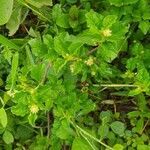Herb with prostrate branches forming mats as much as 0.6 m across, branches leafy. Leaves opposite, petiolate, up to 4.5 x 4 cm, elliptic, broadly ovate or suborbicular, base more or less truncate or abruptly cuneate, margins subentire to coarsely dentate, pubescent above and below, gland-dotted. Heads axillary, pedunculate, 3-5 mm across in flower, about 1.5 cm in fruit. Fertile achenes usually 6-9 in number, radiating from the disc, each achene enveloped in an enlarged involucral bract forming a fusiform-oblong fruit c. 7 mm long covered in short hooked spines. In fruit from about January to June.
Stems prostrate and often rooting, to 6 dm or more, short-hairy, especially distally; lvs broadly rhombic-ovate or triangular, irregularly toothed above the cuneate, entire base, 1.5–3.5 × 1–3 cm, glandular-punctate, on petioles 3–15 mm; heads 4–6 mm wide at anthesis; burs 7–9 mm, ellipsoid-fusiform to nearly oblong, slightly compressed, densely glandular, 5–7-ribbed, the ribs bearing 1 or 2 rows of hooked prickles 1–2 mm, the top abruptly invaginated and with an evident rim; 2n=22. A weed in sandy soil and waste places, native to trop. Amer., and intr. n. occasionally as far as Mass. and Oreg.
Herb with prostate branches forming mats, as much as 0.6 m in diam., branches leafy. Leaves opposite, petiolate, up to 45 x 40 mm, elliptic, broadly ovate or suborbicular, base ± truncate or abruptly cuneate, margins subentire to coarsely dentate, pubescent above and below, gland-dotted. Capitula axillary, pedunculate, 3-5 mm in diam. when flowering, ± 15 mm in fruit. Flowering time Jan.-July. Cypselae usually 6-9 in number, radiating from disc, each enveloped in an enlarged involucral bract; ± 7 mm long, fruit covered by short, hooked spines.
Plants 10–60(–120+) cm. Stems ± procumbent. Leaf blades deltate to ± rhombic or ovate, 13–37 × 7–32 mm, faces sparsely scabrellous to glabrate or glabrescent, gland-dotted. Fruits plumply ellipsoid to fusiform, weakly compressed, 7–9+ mm, 5–7-ribbed, lacking terminal spines, prickles ± uncinate, mostly along ribs. 2n = 22.
Herb with prostrate branches. Leaves and stems usually densely pubescent. Fruits typically 6 or 7(8 or 9) in a head, ± 7 mm long, oblong-fusiform, covered in short hooked spines, all much the same size. Flowers yellowish.

